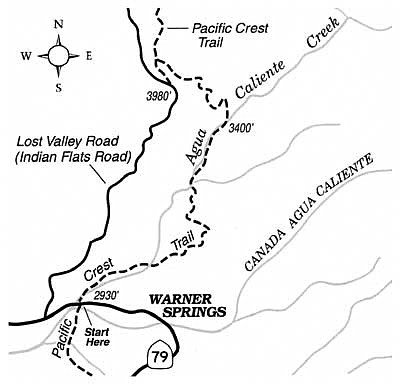 Facebook
Facebook
 X
X
 Instagram
Instagram
 TikTok
TikTok
 Youtube
Youtube
Until about 30 years ago, the canyon of Agua Caliente Creek, in the Cleveland National Forest above Warner Springs, seldom saw the intrusion of humans. After the 2600-mile-long Pacific Crest Trail was routed through, it became recognized as a pleasant camping spot for backpackers heading north toward Canada or south toward Mexico. This is one of only four places in San Diego County where the PCT dips to cross a fairly dependable stream, and the only place in the county where that trail closely follows running water for a fair distance. You can walk a total of eight miles round trip (out and back) to enjoy the most interesting stretch of the canyon.
Begin at the Agua Caliente Creek bridge at mile 36.6 on Highway 79, 1.3 miles west of Warner Springs. There's a turnout for parking just west (mile 36.7) and a dirt road slanting over to where the PCT crosses under the highway. Proceed upstream along the cottonwood-shaded creek, first on the left (north) bank, then on the right. In this first mile, the trail goes through Warner Ranch resort property on an easement. Near the Cleveland National Forest boundary, the canyon narrows, and water trickes or gushes (depending on recent rainfall) out of a narrow declivity.

The trail detours a rough section of canyon ahead by swinging to the east and climbing moderately onto gentle slopes smothered with soft-looking ribbonwood chaparral, and sparsely dotted with cholla and prickly pear cactus. Horseback riders have worn in trails that intersect the PCT here and there, so staying on the correct route may prove a little challenging. After about 1.5 miles of somewhat tedious twisting and turning in the chaparral, you end up down along the bank of the creek again.
Ahead, for a mile or more, lies an appealing stretch of twisting canyon bottom, lined with live oaks, sycamores, and willows, all festooned this month with fresh green leaves. The PCT crosses the creek several times (these may be foot-wetting fords during the next month or two) and strikes up-slope to avoid the rockier, rougher stretches of the canyon bottom. Eventually, the trail veers sharply left and begins a switchbacking ascent northwest up dry slopes toward Lost Valley Road. You've come four miles and reached a good spot to turn around and return the same way.
This article contains information about a publicly owned recreation or wilderness area. Trails and pathways are not necessarily marked. Conditions can change rapidly. Hikers should be properly equipped and have safety and navigational skills. The Reader and Jerry Schad assume no responsibility for any detrimental experience.

Until about 30 years ago, the canyon of Agua Caliente Creek, in the Cleveland National Forest above Warner Springs, seldom saw the intrusion of humans. After the 2600-mile-long Pacific Crest Trail was routed through, it became recognized as a pleasant camping spot for backpackers heading north toward Canada or south toward Mexico. This is one of only four places in San Diego County where the PCT dips to cross a fairly dependable stream, and the only place in the county where that trail closely follows running water for a fair distance. You can walk a total of eight miles round trip (out and back) to enjoy the most interesting stretch of the canyon.
Begin at the Agua Caliente Creek bridge at mile 36.6 on Highway 79, 1.3 miles west of Warner Springs. There's a turnout for parking just west (mile 36.7) and a dirt road slanting over to where the PCT crosses under the highway. Proceed upstream along the cottonwood-shaded creek, first on the left (north) bank, then on the right. In this first mile, the trail goes through Warner Ranch resort property on an easement. Near the Cleveland National Forest boundary, the canyon narrows, and water trickes or gushes (depending on recent rainfall) out of a narrow declivity.

The trail detours a rough section of canyon ahead by swinging to the east and climbing moderately onto gentle slopes smothered with soft-looking ribbonwood chaparral, and sparsely dotted with cholla and prickly pear cactus. Horseback riders have worn in trails that intersect the PCT here and there, so staying on the correct route may prove a little challenging. After about 1.5 miles of somewhat tedious twisting and turning in the chaparral, you end up down along the bank of the creek again.
Ahead, for a mile or more, lies an appealing stretch of twisting canyon bottom, lined with live oaks, sycamores, and willows, all festooned this month with fresh green leaves. The PCT crosses the creek several times (these may be foot-wetting fords during the next month or two) and strikes up-slope to avoid the rockier, rougher stretches of the canyon bottom. Eventually, the trail veers sharply left and begins a switchbacking ascent northwest up dry slopes toward Lost Valley Road. You've come four miles and reached a good spot to turn around and return the same way.
This article contains information about a publicly owned recreation or wilderness area. Trails and pathways are not necessarily marked. Conditions can change rapidly. Hikers should be properly equipped and have safety and navigational skills. The Reader and Jerry Schad assume no responsibility for any detrimental experience.
Comments